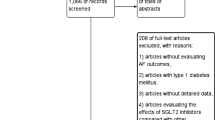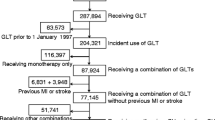Abstract
Aims
To gain insights on the cardiovascular effects of metformin and sulphonylurea, the present study compares the rates of incident atrial fibrillation, stroke, cardiovascular mortality and all-cause mortality between metformin and sulphonylurea users in type 2 diabetes mellitus.
Methods
This was a retrospective population-based cohort study of type 2 diabetes mellitus patients receiving either sulphonylurea or metformin monotherapy between January 1, 2000, and December 31, 2019. The primary outcome was new-onset AF or stroke. Secondary outcomes were cardiovascular, non-cardiovascular and all-cause mortality. Propensity score matching (1:2 ratio) between sulphonylurea and metformin users was performed, based on demographics, CHA-DS-VASc score, past comorbidities and medication use. Cox regression was used to identify significant risk factors. Competing risk analysis was conducted using cause-specific and subdistribution hazard models. Sensitivity analyses using propensity score stratification, high-dimensional propensity score and inverse probability of treatment weighting were conducted. Subgroup analyses were conducted for age and gender in the matched cohort.
Results
A total of 36,228 sulphonylurea users and 72,456 metformin users were included in the propensity score-matched cohort. Multivariable Cox regression showed that sulphonylurea users had higher risks of incident AF (hazard ratio [HR]: 2.89, 95% confidence interval [CI]: 2.75–3.77; P < 0.0001), stroke (HR: 3.23, 95% CI: 3.01–3.45; P < 0.0001), cardiovascular mortality (HR: 3.60, 95% CI: 2.62–4.81; P < 0.0001) and all-cause mortality (HR: 4.35, 95% CI: 3.16–4.75; P < 0.0001) compared to metformin users. Similarly, significant results were observed using cause-specific and subdistribution hazard models. Sensitivity analysis using techniques based on the propensity score also yielded similar results.
Conclusions
Sulphonylurea use was associated with higher risks of incident AF, stroke, cardiovascular mortality and all-cause mortality compared to metformin. Males and patients older than 65 years with sulphonylurea use were exposed to the highest risks.





Similar content being viewed by others
Data availability
The data will be available upon requests to the corresponding authors.
References
Bertoni AG, Krop JS, Anderson GF et al (2002) Diabetes-related morbidity and mortality in a national sample of US elders. Diabetes Care 25(3):471–475
Osei K (2003) Global epidemic of type 2 diabetes: implications for developing countries. Ethn Dis 13(2 Suppl 2):S102–S106
Ogurtsova K, da Rocha Fernandes JD, Huang Y et al (2017) IDF Diabetes atlas: global estimates for the prevalence of diabetes for 2015 and 2040. Diabetes Res Clin Pract 128:40–50
Lin PJ, Kent DM, Winn A et al (2015) Multiple chronic conditions in type 2 diabetes mellitus: prevalence and consequences. Am J Manag Care 21(1):e23–34
Watanabe H, Tanabe N, Watanabe T et al (2008) Metabolic syndrome and risk of development of atrial fibrillation: the Niigata preventive medicine study. Circulation 117(10):1255–1260
Huggett RJ, Scott EM, Gilbey SG et al (2003) Impact of type 2 diabetes mellitus on sympathetic neural mechanisms in hypertension. Circulation 108(25):3097–3101
Huxley RR, Filion KB, Konety S et al (2011) Meta-analysis of cohort and case-control studies of type 2 diabetes mellitus and risk of atrial fibrillation. Am J Cardiol 108(1):56–62
Seyed Ahmadi S, Svensson A-M, Pivodic A et al (2020) Risk of atrial fibrillation in persons with type 2 diabetes and the excess risk in relation to glycaemic control and renal function: a Swedish cohort study. Cardiovasc Diabetol 19(1):9
Paneni F, Beckman JA, Creager MA et al (2013) Diabetes and vascular disease: pathophysiology, clinical consequences, and medical therapy: part I. Eur Heart J 34(31):2436–2443
Tesfamariam B, Brown ML, Cohen RA (1991) Elevated glucose impairs endothelium-dependent relaxation by activating protein kinase C. J Clin Invest 87(5):1643–1648
Zabala A, Darsalia V, Holzmann MJ et al (2020) Risk of first stroke in people with type 2 diabetes and its relation to glycaemic control: a nationwide observational study. Diabetes Obes Metab 22(2):182–190
American Diabetes A (2015) (7) Approaches to glycemic treatment. Diabetes Care 38:S41–S48
Whitlock RH, Hougen I, Komenda P et al (2020) A Safety comparison of metformin vs sulfonylurea initiation in patients with type 2 diabetes and chronic kidney disease: a retrospective cohort study. Mayo Clin Proc 95(1):90–100
Christensen DH, Rungby J, Thomsen RW (2016) Nationwide trends in glucose-lowering drug use, Denmark, 1999–2014. Clin Epidemiol 8:381–387
Douros A, Dell'Aniello S, Yu OHY et al (2018) Sulfonylureas as second line drugs in type 2 diabetes and the risk of cardiovascular and hypoglycaemic events: population based cohort study. BMJ 362:
Hemmingsen B, Schroll JB, Wetterslev J et al (2014) Sulfonylurea versus metformin monotherapy in patients with type 2 diabetes: a Cochrane systematic review and meta-analysis of randomized clinical trials and trial sequential analysis. CMAJ Open 2(3):E162–E175
Mui JV, Zhou J, Lee S et al (2021) Sodium-glucose cotransporter 2 (SGLT) inhibitors vs. dipeptidyl peptidase-4 (DPP4) inhibitors for new-onset dementia: a propensity score-matched population-based study with competing risk analysis. Front Cardiovasc Med 8:747620
Austin PC (2011) An introduction to propensity score methods for reducing the effects of confounding in observational studies. Multivariate Behav Res 46(3):399–424
Desai RJ, Franklin JM (2019) Alternative approaches for confounding adjustment in observational studies using weighting based on the propensity score: a primer for practitioners. BMJ 367:l5657
Schneeweiss S, Rassen JA, Glynn RJ et al (2009) High-dimensional propensity score adjustment in studies of treatment effects using health care claims data. Epidemiology 20(4):512–522
Lee S, Zhou J, Wong WT et al (2021) Glycemic and lipid variability for predicting complications and mortality in diabetes mellitus using machine learning. BMC Endocr Disord 21(1):
Zhang L, Ji L, Guo L et al (2015) Treatment patterns and glycemic control in older adults with type 2 diabetes mellitus receiving only oral antidiabetes drugs in China. Diabetes Technol Ther 17(11):816–824
Roumie CL, Min JY, D'Agostino McGowan L et al (2017) Comparative safety of sulfonylurea and metformin monotherapy on the risk of heart failure: a cohort study. J Am Heart Assoc 6(4):871
Palmer SC, Mavridis D, Nicolucci A et al (2016) Comparison of clinical outcomes and adverse events associated with glucose-lowering drugs in patients with type 2 diabetes: a meta-analysis. JAMA 316(3):313–324
Bonds DE, Miller ME, Bergenstal RM et al (2010) The association between symptomatic, severe hypoglycaemia and mortality in type 2 diabetes: retrospective epidemiological analysis of the ACCORD study. BMJ 340:
Pyorala M, Miettinen H, Laakso M et al (2000) Plasma insulin and all-cause, cardiovascular, and noncardiovascular mortality: the 22-year follow-up results of the Helsinki Policemen Study. Diabetes Care 23(8):1097–1102
Reiff S, Fava S (2019) All-cause mortality in patients on sulphonylurea monotherapy compared to metformin monotherapy in a nation-wide cohort. Diabetes Res Clin Pract 147:62–66
Azoulay L, Suissa S (2017) Sulfonylureas and the risks of cardiovascular events and death: a methodological meta-regression analysis of the observational studies. Diabetes Care 40(5):706–714
Belfiore A, Malaguarnera R (2011) Insulin receptor and cancer. Endocr Relat Cancer 18(4):R125–R147
Soranna D, Scotti L, Zambon A et al (2012) Cancer risk associated with use of metformin and sulfonylurea in type 2 diabetes: a meta-analysis. Oncologist 17(6):813–822
Singh S, Loke YK, Furberg CD (2011) Long-term use of thiazolidinediones and the associated risk of pneumonia or lower respiratory tract infection: systematic review and meta-analysis. Thorax 66(5):383–388
Hung AM, Roumie CL, Greevy RA et al (2013) Kidney function decline in metformin versus sulfonylurea initiators: assessmentof time-dependent contribution of weight, blood pressure, and glycemic control. Pharmacoepidemiol Drug Saf 22(6):623–631
Orkaby AR, Cho K, Cormack J et al (2017) Metformin vs sulfonylurea use and risk of dementia in US veterans aged >/=65 years with diabetes. Neurology 89(18):1877–1885
Gorricho J, Garjon J, Alonso A et al (2017) Use of oral antidiabetic agents and risk of community-acquired pneumonia: a nested case-control study. Br J Clin Pharmacol 83(9):2034–2044
Cho E-H, Han K, Kim B et al (2020) Gliclazide monotherapy increases risks of all-cause mortality and has similar risk of acute myocardial infarction and stroke with glimepiride monotherapy in Korean type 2 diabetes mellitus. Medicine 99(29):e21236–e21236
Sun Y, Hu D (2010) The link between diabetes and atrial fibrillation: cause or correlation? J Cardiovasc Dis Res 1(1):10–11
Benjamin EJ, Levy D, Vaziri SM et al (1994) Independent risk factors for atrial fibrillation in a population-based cohort. The Framingham Heart Study JAMA 71(11):840–844
Ostropolets A, Elias PA, Reyes MV et al (2021) Metformin is associated with a lower risk of atrial fibrillation and ventricular arrhythmias compared with sulfonylureas: an observational study. Circ Arrhythm Electrophysiol 14(3):
Isoda K, Young JL, Zirlik A et al (2006) Metformin inhibits proinflammatory responses and nuclear factor-kappaB in human vascular wall cells. Arterioscler Thromb Vasc Biol 26(3):611–617
Ren H, Shao Y, Wu C (2020) Metformin alleviates oxidative stress and enhances autophagy in diabetic kidney disease via AMPK/SIRT1-FoxO1 pathway. Mol Cell Endocrinol 500:
Xie F, Xu S, Lu Y et al (2021) Metformin accelerates zebrafish heart regeneration by inducing autophagy. NPJ Regen Med 6(1):62
Leonard CE, Hennessy S, Han X et al (2017) Pro- and antiarrhythmic actions of sulfonylureas: mechanistic and clinical evidence. Trends Endocrinol Metab 28(8):561–586
Jia J, Cheng J, Ni J et al (2015) Neuropharmacological actions of metformin in stroke. Curr Neuropharmacol 13(3):389–394
Jin Q, Cheng J, Liu Y et al (2014) Improvement of functional recovery by chronic metformin treatment is associated with enhanced alternative activation of microglia/macrophages and increased angiogenesis and neurogenesis following experimental stroke. Brain Behav Immun 40:131–142
Ashabi G, Khalaj L, Khodagholi F et al (2015) Pre-treatment with metformin activates Nrf2 antioxidant pathways and inhibits inflammatory responses through induction of AMPK after transient global cerebral ischemia. Metab Brain Dis 30(3):747–754
Joy NG, Tate DB, Younk LM et al (2015) Effects of acute and antecedent hypoglycemia on endothelial function and markers of atherothrombotic balance in healthy humans. Diabetes 64(7):2571–2580
Razavi Nematollahi L, Kitabchi AE, Stentz FB et al (2009) Proinflammatory cytokines in response to insulin-induced hypoglycemic stress in healthy subjects. Metabolism 58(4):443–448
Marx N, Walcher D, Raichle C et al (2004) C-peptide colocalizes with macrophages in early arteriosclerotic lesions of diabetic subjects and induces monocyte chemotaxis in vitro. Arterioscler Thromb Vasc Biol 24(3):540–545
Funding
There is no funding for this project to declare.
Author information
Authors and Affiliations
Contributions
JD, GZ, CC and OHIC carried out data analysis, data interpretation, statistical analysis, manuscript drafting and critical revision of manuscript. SL, KSKL, WTW, TL, AKCW and SHC were involved in project planning, data acquisition, data interpretation and critical revision of manuscript. QZ and GT took part in study conception, study supervision, project planning, data interpretation, statistical analysis, manuscript drafting and critical revision of manuscript.
Corresponding authors
Ethics declarations
Conflict of interest
The authors have no conflicts of interest to declare.
Ethical approval
This retrospective population-based cohort study received approval from the Joint Chinese University of Hong Kong—New Territories East Cluster Clinical Research Ethics Committee.
Consent for publication
All authors have read and approved submission of the manuscript which has not been published and is not being considered for publication elsewhere in whole or part in any language.
Additional information
Managed by: Massimo Porta
Publisher's Note
Springer Nature remains neutral with regard to jurisdictional claims in published maps and institutional affiliations.
Supplementary Information
Below is the link to the electronic supplementary material.
Rights and permissions
About this article
Cite this article
Zhou, J., Zhang, G., Chang, C. et al. Metformin versus sulphonylureas for new onset atrial fibrillation and stroke in type 2 diabetes mellitus: a population-based study. Acta Diabetol 59, 697–709 (2022). https://doi.org/10.1007/s00592-021-01841-4
Received:
Accepted:
Published:
Issue Date:
DOI: https://doi.org/10.1007/s00592-021-01841-4




